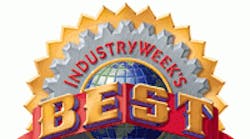Bowater Inc., Catawba Operations, Catawba, S.C.
Employees: 976, union
Total square footage: 1,752,583
Primary products: coated paper, market pulp
Start-up: 1959
Achievements: Bowater's Catawba Operations received the 2004 South Carolina Manufacturer of the Year award. It has surpassed 6 million work hours without a lost-time injury. Two-thirds of the total energy used at the Catawba Operations comes from biomass and other renewable energy sources.
Ol' Blue may be pushing 40, but its advanced age has not stopped the No. 3 paper machine at Bowater Inc.'s Catawba Operations from producing record-setting output.
At the opposite age extreme, the relative youth and new technology of the Catawba, S.C., pulp and paper manufacturer's new kraft pulp mill did not prevent it from producing pulp at full capacity within two weeks after start-up. Bowater says the start-up of the new kraft mill, known as the fiberline, was the best in industry history, based on benchmarking data it sought out on stellar start-ups.
The facility is defined by "an unrelenting pursuit of excellence in everything we do," explains Jay C. Thiessen, director of technical and process services.
That philosophy serves Bowater's Catawba Operations well. The complex reports a 96.3% first-pass yield across all of its finished products; warranty costs are down more than 41% in the past three years; and the manufacturing cycle time for a typical finished product has dropped by nearly a third in that same three-year time frame.
The sprawling complex, located about 40 minutes south of the Charlotte, N.C., airport, includes three paper machines, each housed in a separate building, and a pulp dryer. It also encompasses two wood yards, power house, two pulp mills, finishing and shipping operations and a wastewater treatment plant. So sprawling is it that maintenance workers pedal around on bicycles to travel from one location to another. The plant operates seven days a week, 24 hours a day.
The Catawba Operations manufactures market pulp and coated paper. In 2004 Bowater Catawba produced about 900,000 tons of product. The coated paper, which has a polished, glossy finish, is shipped to customers for use in magazines, catalogs and inserts. Market pulp goes to customers for use in other paper products, such as paper towels.
And production from the No. 3 paper machine following its conversion has exceeded expectations. For instance, the design average production rate for Ol' Blue is 887 tons per day -- this at the end of a 30-month ramp-up period. However, Ol' Blue's production surpassed that after just 12 months -- and established a record production month in May 2005 when it produced nearly 1,000 tons per day. Ol' Blue produces enough 30-foot wide paper every 23 days to circle the Earth at the equator.
"We're running way above what [was] expected. That's good team thinking," says G.L. "Bud" Nash, vice president and resident manager at Bowater's Catawba Operations.
And there's the new fiberline, whose huge digestor resembles nothing so much as a rocket sitting on a launchpad, prepared for takeoff. The kraft mill's control room, too, is a scene straight from NASA mission control, with a wealth of computer monitors flashing real-time information picked up from "literally thousands of sensors" keeping a constant eye on the pulping facility. The fiberline, which converts wood chips to pulp using chemicals, was constructed to meet and exceed new Environmental Protection Agency requirements.
But capital investment alone did not propel the tremendous start-up of the fiberline, which continues to operate well ahead of its start-up plan. Top-notch employee training was a key contributor. "The difference is in the preparedness of the people," states Victor L. Bilodeau, project manager of the fiberline.
Indeed, the Catawba Operations provided extensive training for employees moving to the new kraft mill at what it dubbed "Fiberline University." Before beginning training, however, each of the 25 kraft mill workers had to pass tests in such areas as reading, math and applied technology, with remedial training offered to those who needed it. Then began 40 hours of classroom training for operators every fifth week, beginning nine months before the fiberline started up. (A fifth shift was added to allow all operators to receive their training.) Additionally, employees learned how to operate the fiberline using a process simulator. Once training was complete, employees were required to pass a final exam to qualify for the fiberline.
The facility also employs extensive pre-hire training to ensure that any new person it brings aboard has a basic level of knowledge. "The net result [of our pre-hire and new hire training] is that by the time they come through, they have had 76 to 80 hours of training already," explains Kenny D. Sawyer, director of human resources.
But again, the Catawba's insistence on educated employees doesn't end there. The facility provides opportunity for continuing education. For example, Bilodeau completed his master's degree in Charlotte while leading the project to build the new kraft mill. Two of the complex's security guards received their bachelor's degrees while on the job. Soon, the paper mill will begin offering satellite and on-site classes from the University of South Carolina to its employees.
Further, 23 of the 26 employees who received master's degrees at Winthrop University in nearby Rock Hill, S.C., since 1990 are still at the Catawba facility. That means expertise remains in-house.
| IndustryWeek is now accepting nominations for the 2006 IW Best Plants Program. |
What you don't hear much of at the Catawba Operations is "lean this" or "lean that" peppering conversations. Yet continuous improvement is inextricably interwoven into the fabric of this paper plant via the facility's Cost Assessment and Profit Improvement program, via process personnel being challenged to "draw straight lines" with their processes and via "just scratching our heads and thinking 'how can we do this better?' "
"We have high expectations," Nash says, "and high expectations are hard work."



